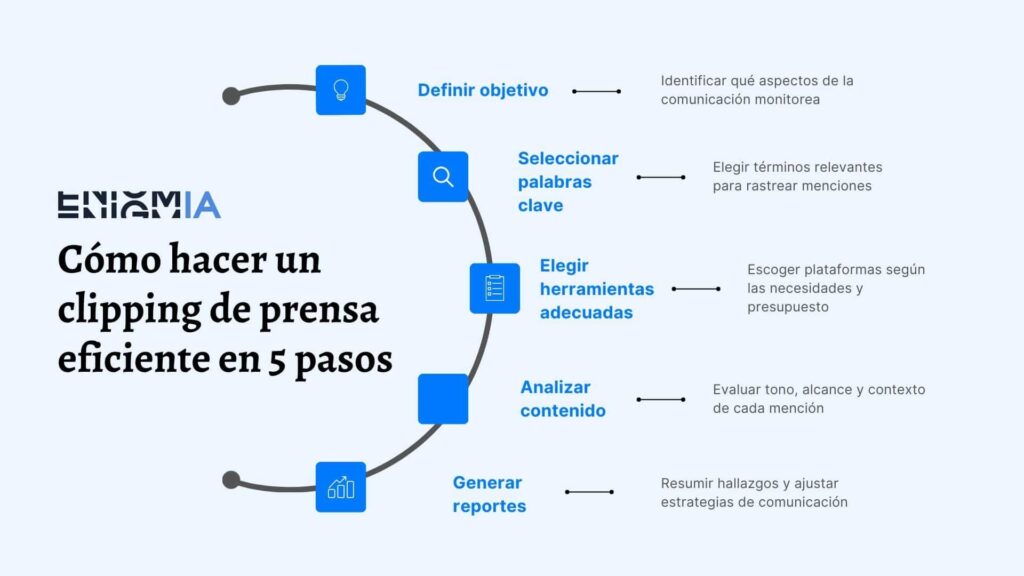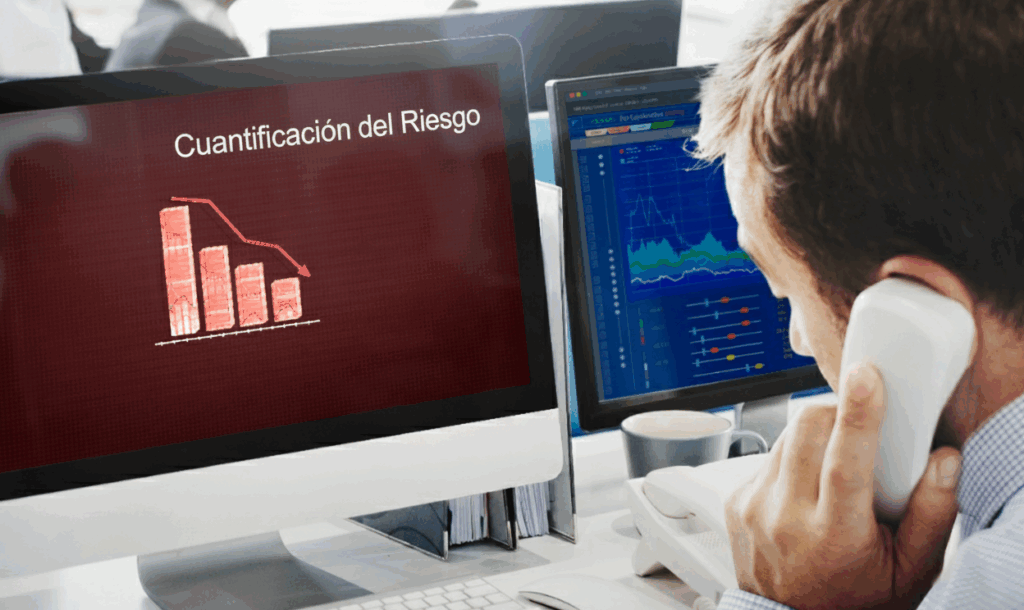The press clipping is a communication tool used to collect and analyze the mentions that a media outlet makes about a company, brand, person or specific topic. This process is fundamental to monitor reputation and measure the impact of a communication strategy in the media.
For many companies, media monitoring is an essential resource in the management of corporate reputation and brand visibility, as it allows them to make informed decisions based on the analysis of mentions and coverage obtained in the media.
What is press clipping?

Press tracking is the process of collecting, monitoring and analyzing content in which a brand, company or individual is mentioned in the media. Over time, the concept has evolved from manual clipping of newspaper articles to advanced digital tools that allow tracking across multiple channels, including print, digital, social media, radio and television.
The evolution of press clipping: from paper to digital
Originally, press clipping consisted of a manual job of clipping and archiving news. Communication agencies or public relations departments would go through newspapers and magazines on a daily basis to select relevant articles and file them in physical folders. This technique, while effective at the time, was tedious and limited, as it only involved print media and relied on physical access to publications.
With the digitalization of the media, press clipping has taken a significant leap forward, allowing companies to monitor their media presence in real time and more accurately. Today, there are digital press clipping tools that not only track mentions in the digital press, but also in blogs, social networks, video platforms and even podcasts, expanding the scope and accuracy of monitoring.
Functionality of press clipping
The main objective of press clipping is to capture all relevant mentions for the brand, whether it is an article, interview, press release or mention in social networks. To achieve this, specific keywords are defined in advance, such as company name, products, services or topics of interest. By configuring these keywords in the clipping tools, mentions are captured automatically, providing real-time alerts that allow communication managers to react quickly.
In addition to collecting mentions, press clipping allows to analyze the captured content, evaluating the context and tone of the news to better understand how the brand is perceived. This analysis also helps to identify trends, opportunities for improvement and potential reputational risks, allowing companies to adjust their communication strategy in a timely manner.
Scope of application of media control
Press clipping is widely used in various sectors, from large corporations to institutions and public figures. Its application covers different areas:
- Companies and brandsClipping: They use clipping to measure the impact of their advertising and public relations campaigns.
- Governments and organizationsThey use it to monitor public opinion on policies and programs.
- Public personalitiesActors, politicians and other figures monitor their image and public perception.
For each area, press clipping offers a unique perspective on how the media and the public perceive the activity or image of the entity or person, helping to define and adjust messages according to the findings.
Benefits of efficient news monitoring
Press clipping not only allows to monitor mentions, but also offers other strategic benefits. Through constant monitoring and analysis of mentions, companies can obtain:
- Brand visibility: Knowing in which media the company appears and how many times it has been mentioned helps to evaluate visibility and reach.
- Public perception analysis: Observing how the brand is talked about and in what tone allows you to adjust key messages.
- Identification of trends: Detecting recurring themes in the industry and emerging trends provides a competitive advantage.
With these functions, press clipping becomes an essential tool for communication strategy, allowing companies to make decisions based on real information and data.
▶ You may be interested in: What is clipping and what is it used for in the press, radio and television?
Why is it important to monitor news in the press?
Press clipping is a key tool for any communication strategy, as it allows companies and organizations to understand how they are perceived in the media. Implementing a press clipping system has multiple benefits that go beyond the mere collection of media mentions. By analyzing this information, companies can measure the impact of their communication efforts, adjust strategies and improve their reputation. Below, we explore in depth the reasons why press clipping is so important.
Reputation monitoring
The main objective of press clipping is to monitor the reputation of a brand or company. Thanks to this practice, communication teams can closely follow how the brand is talked about in the media and detect in time any change in public perception. Knowing whether a mention is positive, negative or neutral allows them to react quickly and appropriately, avoiding or mitigating possible reputational crises.
For example, if a company receives criticism in several media, press clipping will allow to detect this trend and respond before it escalates into a major crisis. Thus, reputation monitoring not only helps to manage public image, but also to identify risks and opportunities for communication.
2. Measuring the impact of communication strategies
Another crucial aspect of press clipping is the ability to measure the impact of communication and public relations strategies. By analyzing the number and type of mentions in the press and other media, companies can evaluate the effectiveness of their campaigns and the return on investment (ROI) of their communication efforts. This analysis allows to know, for example, if a press release achieved the expected visibility or if the media coverage was positive and in line with the corporate message.
In addition, press clipping allows the analysis to be segmented by region, language or media type, facilitating a more accurate and detailed evaluation. This information is essential to optimize future strategies and adjust messages to better resonate with the audience.
3. Optimization and adjustment of key messages
Implementing a press clipping system makes it easier for companies to adjust their key messages based on how they are received by the media and the public. By analyzing mentions, it is possible to identify whether messages are being well interpreted or whether adjustments need to be made to improve communication. This adjustment may involve changes in tone, the topics addressed or the way the company's values are presented.
For example, if a company detects that certain terms or phrases generate confusion, it can modify its discourse to make the message clearer and more direct. This process of optimizing key messages, based on press clipping analysis, ensures a more effective communication in tune with the public's expectations.
4. Identification of public relations opportunities
Press clipping not only allows you to detect threats, but also to identify public relations opportunities that could benefit your brand. Observing how the company or the sector in general is talked about allows to detect emerging topics, trends and possible collaborations with other market players. These opportunities can be used to improve visibility and position the brand on relevant topics, helping to strengthen its image and its relationship with the public.
For example, if press clipping analysis reveals that a specific topic is gaining popularity in the media, the company can generate related content, issue press releases or seek partnerships to increase its presence on that topic. This proactive strategy helps to gain relevance and to be always aligned with industry trends.
5. Evaluation of the media context and competition
Press clipping not only provides information on brand mentions, but also allows you to understand the general media context and analyze your competitors' activities. Knowing how other companies are positioned and what kind of coverage they receive can provide valuable insights for adjusting one's own communication strategy. This comparative vision helps to identify the brand's strengths and weaknesses vis-à-vis its competitors and to detect opportunities to stand out in specific topics or sectors.
For example, if a company observes that a competitor is receiving positive coverage for sustainability issues, it may consider highlighting its own initiatives in that area. In this way, press clipping becomes a strategic tool not only to evaluate one's own performance, but also to observe the competitive landscape and continuously improve communication.
Tools for effective press clipping
The success of a press clipping lies in having the right tools to monitor, analyze and manage the information obtained in real time. Today, there are advanced platforms that automate this process, allowing companies to control their reputation and adjust their communication strategies quickly and accurately. Below is a selection of tools.
ENIGMIAArtificial Intelligence for Media Monitoring
The services of ENIGM clippingIA with Artificial Intelligence analyze 100% of news in real time, covering more than one million global media in TV, radio, press, newsletters, call centers and social networks in any language. It allows to monitor reputation and detect key trends to optimize communication strategies.
ENIGMIA evaluates not only the company's image, but also that of its competitors, offering a thorough analysis of the impact of each communication action and identifying reputation drivers. Its AI platform provides a complete and detailed analysis of digital and offline presence through the Reputation Index (RI), a unique algorithm that measures reputation on a scale from 0 to 10, considering variables such as:
- Dimensions and attributes
- Media and audience
- Protagonism and feeling
- Location and authors
Unlike other services, ENIGMIA monitors the 100% of publications, extracting, processing and analyzing both public and private sources every 24 hours or every hour. The platform also allows comparing the KPIs of a company's reputation with those of its competitors, providing strategic information about its position in the market.
¡Request a demo today and experience a new dimension in the management of your corporate reputation!
Meltwater: global media coverage and sentiment analysis
Meltwater is a recognized tool for press clipping in digital media, social networks, radio and television. This platform offers detailed analysis of mentions, including metrics such as sentiment (positive, negative or neutral) and the potential reach of each publication. Meltwater also allows you to filter results by region, language and media type, facilitating personalized and comprehensive brand reputation monitoring.
Meltwater stands out for its ability to integrate clipping results into automated reports, which is ideal for communications teams that need regular reporting and a global view of media presence.
Cision: analysis of impact and visibility in digital media
Commission is another robust platform in the field of press clipping, designed to measure the impact of mentions in digital media and social networks. Cision allows tracking mentions in real time and offers analysis tools to identify influencers and evaluate the impact of communication campaigns. In addition, Cision facilitates the creation of customized reports, which is useful for comparing the visibility of the brand with that of its competitors.
One of Cision's advantages is its ability to integrate clipping information with public relations campaigns, optimizing brand visibility on different platforms.
Google Alerts: free option for basic mentions
Google Alerts is a free option that allows you to receive email alerts whenever specific mentions are detected on the web. Although Google Alerts is limited compared to other tools, it is useful for small businesses or freelancers looking for a simple solution to monitor mentions on blogs, news and websites.
Although it does not have advanced analysis functions, Google Alerts can be a good starting point for those who want to be aware of mentions in digital media quickly and inexpensively.
Brandwatch: monitoring of social networks and digital media
Brandwatch is a tool specialized in monitoring social networks and digital media, allowing to analyze brand perception on multiple platforms. Brandwatch allows segmenting the clipping by channel, demographics and location, which facilitates a detailed analysis of the audience and public perception. In addition, it has advanced artificial intelligence functions that allow identifying patterns and trends in conversations about the brand.
Brandwatch is ideal for companies that want to focus on social networks and gain valuable insights into the behavior of their followers and the evolution of their digital reputation.
How to make an efficient press clipping in 5 steps
Perform a press clipping Effective media reputation monitoring requires following a series of steps to obtain accurate information and make the most of it for the company's communication strategy. Below, we present the five essential steps to carry out an efficient media reputation monitoring and achieve an optimal management of your brand's reputation and visibility in the media.

Step 1: Define the objectives of press clipping
The first step to efficient press clipping is to clearly define the objectives. Before you start collecting mentions, it is essential to establish what aspects of communication you want to monitor and why. Do you want to measure the impact of a specific campaign? Are you looking to know the public perception of your brand? Or maybe you need to evaluate the media coverage of an issue relevant to your industry?
Defining clear objectives will help focus the process and allow the selection of the most appropriate keywords and monitoring tools. For example, if the objective is to analyze the coverage of a campaign, the terms to follow could include the name of the campaign, the name of the brand and terms associated with the message that has been transmitted.
Step 2: Select relevant keywords
Once the objectives have been defined, it is essential to select keywords that will guide the media monitoring. Keywords represent the terms and phrases you want the press clipping to track. This can include the name of the company, products or services, specific terms of a campaign, or even the name of competitors for comparative analysis.
It is advisable to include variations and possible common mistakes in keyword spelling to avoid losing relevant mentions. It is also useful to update keywords periodically, especially if new products or campaigns are launched. Using accurate keywords ensures that press clipping captures relevant information and minimizes the noise of irrelevant mentions.
Step 3: Choose appropriate press clipping tools
To perform an efficient press clipping, it is necessary to have the right tools to monitor media accurately and in real time. There are several clipping tools available, from free options such as Google Alerts to advanced platforms such as ENIGMIA which offers Artificial Intelligence monitoring and analysis of more than one million global media.
Choosing a tool that fits your needs and budget is key to optimize the process of news monitoring. It is important to consider factors such as scope of coverage, update frequency and real-time analytics capability. In addition, assessing the type of media and the level of detail that needs to be monitored (such as TV, radio, social networks or digital media) will help define which tool is the most appropriate. The right choice will allow you to collect and analyze mentions efficiently and comprehensively, facilitating decision-making in your communication strategy.
Step 4: Analyze the collected content
After compiling the media mentions, the next step is to analyze the content to obtain relevant insights. This analysis should include an evaluation of the tone of the mentions (positive, negative or neutral), the reach of each publication and the context in which the brand has been mentioned. Analyzing these factors helps to understand how the brand is perceived in the media and to detect trends or recurring themes.
In addition, the analysis of press clipping can identify opportunities for improvement in the communication strategy. For example, if an increase in negative mentions is detected, it may be necessary to adjust the message or issue a press release to mitigate the impact. It is also useful to segment mentions by media type or geographic location, especially if the brand has an international presence. This makes it easier to adapt the message and improve the communication strategy based on the results obtained.
Step 5: Generate reports and share the findings
The last step in the process of press clipping is to generate reports summarizing the most important findings. Reports are useful for communicating the results of press reports to the various teams in the company and allow for informed decision making. A good report should include a summary of mentions, sentiment analysis, trends detected and any relevant findings on brand perception.
In addition to sharing results on a regular basis, it is important to review reports to adjust communication strategies based on the data collected. The frequency of reports may vary according to the needs of the company; some brands prefer weekly reports, while others opt for monthly reports or after the launch of a specific campaign. In any case, regular reporting ensures that the company maintains constant control over its reputation in the media and can respond proactively to any changes in public perception.
In short, press clipping is an essential tool for any company seeking to effectively manage its reputation and improve its media presence. Integrated into the communication strategy, it allows real-time monitoring of how the brand is perceived in the media, identifying opportunities for improvement and acting quickly in the face of possible crises. By using advanced tools such as ENIGMIAIn an increasingly dynamic media environment, press clipping is a key investment to lead and protect corporate reputation. In an increasingly dynamic media environment, press clipping is a key investment to lead and protect corporate reputation.





